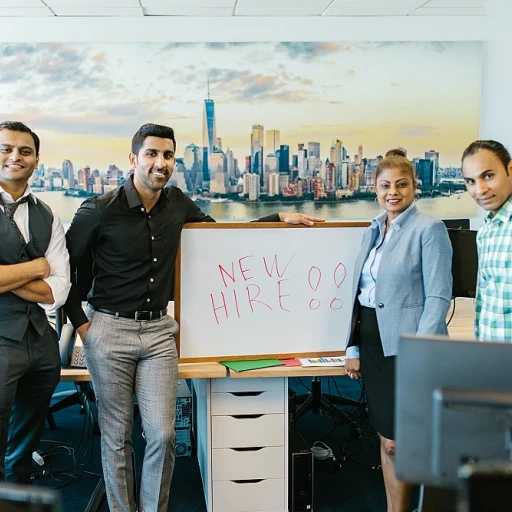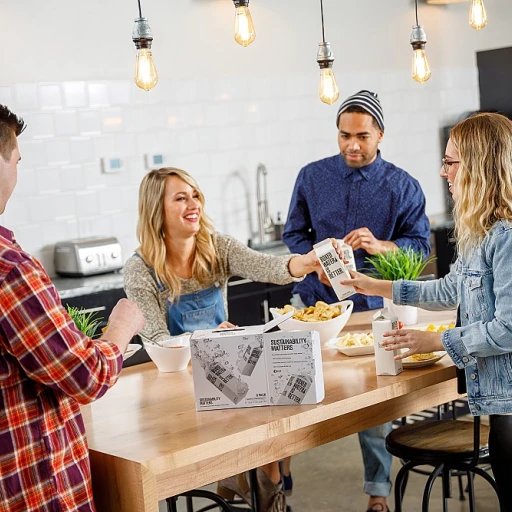
Understanding the Importance of Employee Appreciation
The Vital Role of Employee Appreciation in the Workplace
In today's fast-paced office environment, ensuring that employees feel valued can sometimes take a backseat. However, recognizing the hard work and dedication of your team is crucial for maintaining a positive work atmosphere and enhancing staff morale. When employees feel appreciated, they tend to be more engaged, motivated, and committed to their roles.
An appreciation lunch isn't just a simple meal or an excuse for staff to take a break from their tasks. It's an important opportunity to strengthen team bonding, build connections, and show true appreciation for their efforts. By organizing such events, you're helping to cultivate a culture of recognition that resonates throughout the workplace.
It’s not merely about serving food; it’s a chance to convey your recognition and thanks through thoughtful appreciation ideas. From organizing an ice cream social to serving healthy snacks, there’s an array of lunch ideas to explore. Consider dietary restrictions to ensure all employees feel included.
Beyond the fun and food, appreciation lunches provide a platform for listening to employees’ feedback and suggestions, thereby promoting a culture of open communication and respect. Recognizing their hard work with an appreciation day can improve how employees feel about their contributions to the team's successes.
Overall, integrating employee appreciation events into your organizational strategy is not solely about the event itself but building a long-lasting environment where appreciation is a consistent practice. This level of recognition can significantly impact employee satisfaction and productivity over time.
Planning the Perfect Appreciation Lunch
Crafting a Memorable Appreciation Event
Organizing a standout appreciation lunch calls for meticulous planning and a bit of creativity. Here are some essential steps to ensure your employee appreciation event leaves a lasting impression:- Choose a Theme: Setting a theme can add a fun element and guide your menu and decor choices. This could range from a cultural theme to a seasonal celebration, making the event more engaging for your team.
- Select the Right Venue: Evaluate if the office is suitable, or if an external location would offer a refreshing change. Ensure the space can comfortably accommodate everyone and has the necessary facilities for catering and presentations.
- Menu Planning: Consider dietary restrictions and preferences to ensure every attendee enjoys the meal. Partner with local caterers for diverse and tasty food ideas, such as healthy snacks, food trucks, or an ice cream station. This ensures all employees feel valued and included.
- Plan Engaging Activities: Incorporate icebreakers or team bonding activities to make the day more interactive. This could include appreciation ice breakers or "office superlatives" to add a humorous touch to the event. Check out this guide on unveiling the charm of office superlatives for inspiration.
- Timely Communication: Send out invitations well in advance, ensuring everyone in the staff is informed about the date, time, and venue. Encourage enthusiasm and anticipation by highlighting special aspects of the day, like guest speakers or a surprise element.
Effective Communication Strategies for HR
Optimizing HR Communication for Appreciation Lunches
Crafting effective communication strategies for an employee appreciation lunch is pivotal in ensuring the success of the event. Proper communication lays the groundwork for enhancing employee engagement and making everyone feel valued on appreciation day.- Clear and Inviting Messaging: Begin by creating an engaging announcement message for the appreciation luncheon. Share this through multiple channels such as emails, office notices, and staff meetings. It's important to convey the purpose of the event, highlighting that it is a day dedicated to recognizing employee contributions and fostering team bonding.
- Incorporate Staff Feedback: Prior to the appreciation day, gather input from employees regarding lunch ideas, food preferences, and potential dietary restrictions. This collaborative approach not only ensures that everyone can enjoy the appreciation meal but also empowers employees by making them a part of the decision-making process.
- Logistical Considerations: Address logistical details clearly, such as the date, time, and location of the event. Ensure that the lunch timing aligns with work schedules to maximize participation. Consider including fun elements like appreciation food trucks or an ice cream bar to add excitement.
- Recognition and Engagement: Use the appreciation lunch as an opportunity to engage with employees actively. Organize activities that promote team bonding and highlight individual contributions. Simple gestures such as appreciation awards or shout-outs can significantly impact how employees feel recognized.
Incorporating Feedback and Suggestions
Gathering Valuable Feedback
To ensure your employee appreciation lunch is a success, it's crucial to incorporate feedback and suggestions from your team. This not only helps in planning a more enjoyable event but also makes employees feel valued and heard. After all, the goal is to create an appreciation day that resonates with everyone.
Encouraging Open Communication
Start by encouraging open communication within your office. You can set up anonymous surveys or suggestion boxes where staff can share their appreciation ideas and preferences. Ask about their favorite meal options, dietary restrictions, or any fun activities they might enjoy during the appreciation luncheon. This approach ensures that the event is inclusive and caters to diverse tastes and needs.
Incorporating Team Suggestions
Once you have gathered feedback, incorporate these ideas into your planning. If employees suggest having food trucks or a particular type of catering, consider these options. Offering a variety of appreciation food, such as healthy snacks or even an ice cream station, can make the event more enjoyable. Remember, the more personalized the appreciation lunch, the more your team will feel recognized and appreciated.
Creating a Feedback Loop
After the appreciation event, it's essential to continue the conversation. Ask employees for their thoughts on the lunch ideas and what could be improved for future events. This feedback loop not only helps in planning better appreciation lunches but also fosters a culture of continuous improvement and open dialogue within the workplace.
Building a Culture of Appreciation
Incorporating feedback and suggestions is a step towards building a culture of appreciation that extends beyond just lunches. When employees see their ideas being implemented, they feel more engaged and motivated. This can lead to a more cohesive team and a positive work environment where everyone feels valued.
Measuring the Impact of Appreciation Events
Evaluating the Success of Appreciation Lunches
Measuring the impact of an appreciation event like a lunch requires careful consideration of multiple factors. It's not just about whether the food was tasty or if the ideas staff enjoy the meal, it's about understanding how employees feel recognized and valued.- Gather Feedback: One of the most effective ways to measure the impact is through feedback gathered from the team. Use anonymous surveys or suggestion boxes to capture genuine opinions about the appreciation lunch. Ask employees how the lunch made them feel and if they have any ideas for future events.
- Monitor Engagement: Take note of changes in employee engagement and productivity post-event. You may observe a boost in morale, positive office atmosphere, or increased collaboration among staff, which can indicate that employees feel genuinely appreciated.
- Assess Participation Rates: High attendance at the lunch can signal that employees are interested in participating in such events. It is equally important that the event caters to everyone. Factor in any food ideas or aim for an inclusive approach by accommodating dietary restrictions if necessary. This also applies to appreciation breakfasts or events featuring healthy snacks and ice cream.
- Long-term Impact: Consider the longer-term impact on the team's attitude toward work. Is there a sustained improvement in communication, cls among team members, or enhanced team bonding as a result of the appreciation lunch?
Building a Culture of Appreciation Beyond Lunches
Creating Lasting Appreciation in Workplace Culture
Hosting an appreciation lunch is a wonderful way to recognize employees, but building a culture of appreciation that extends beyond such events is equally important. Consistently acknowledging staff helps employees feel valued every day, fostering an environment where gratitude becomes a norm, not an exception.
Once you've successfully executed an appreciation event, like a lunch or appreciation day, consider how the same energy can be maintained within the workplace:
- Consistent Recognition: Implement regular acknowledgment initiatives. This could be monthly feedback sessions or spontaneous notes of thanks that recognize individual and team achievements.
- Diverse Appreciation Foods: Outside of lunches, consider surprise appreciation snacks or a catered appreciation breakfast. This could include a mix of healthy snacks, food ideas that cater to dietary restrictions, or occasional fun treats like an ice cream day.
- Team Bonding Activities: Encourage activities that promote team bonding. These could be informal events at the office or offsite, and might even involve hiring food trucks for a truly memorable meal experience.
- Engage with Employee Suggestions: Involve employees when planning appreciation initiatives by asking for team appreciation ideas. This empowers employees and ensures events are enjoyable for the entire staff.
By incorporating these ideas into your regular activities, you create an enduring culture where respect and recognition are part of the everyday fabric of work life. In doing so, you not only improve morale during special occasions but also ensure that employees consistently experience a supportive and celebratory workspace.












